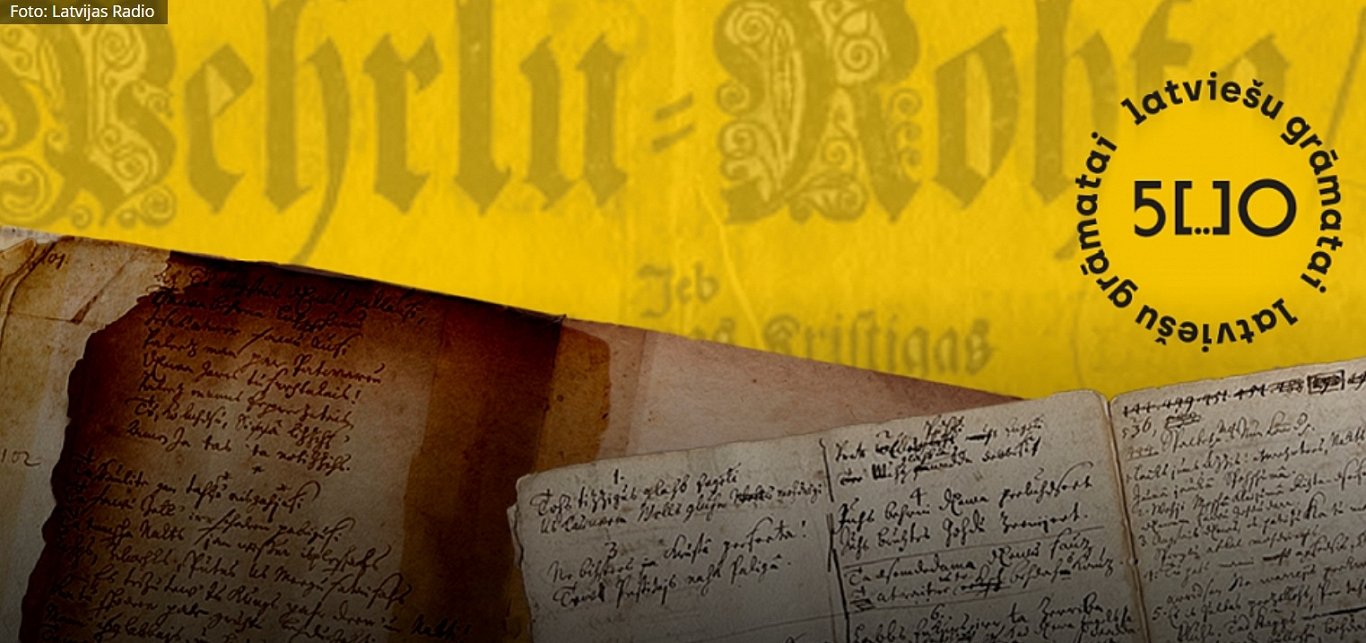More about the cycle of events can be discovered at the website https://www.gramatai500.lv and for more about the Latvian National Library and its constantly changing exhibitions and collections, visit: https://www.lnb.lv/.
The first book in Latvian for women. What were the lessons from the Strings of Spiritual Pearls?
The story of the Baltic German pastor of Smiltene, Svante Gustav Dietz (1670–1723), and his translation of the first book for Latvian women, Strings of Spiritual Pearls (1711), begins with the author of the original book, Johann Cundisius.
In 1667, Cundisius was a printer in Gerlitz and published a pocket-sized book for women, Geistlicher Perlen Schmuck [Strings of Spiritual Pearls]. He was a newcomer from Merseburg and lived in Gerlitz from 1656 onwards. He sold books, became a citizen, worked as a publisher and composed spiritual hymns, but he became most renowned for his books of spiritual prayers and hymns: Bet-, Buß-, Beicht und Speise- Kämmerlein [Little Room of Prayer, Penance and Communion; 1668, 1671, 1672, 1674, 1677, 1683, 1695?, 1715], with 8 reprints; Frommer Christen Tägliches Bet- Kämmerlein [Devotional Christian's Daily Prayer Book 1669], published once; Andächtiges Teutsches Hand-Büchlein: Mit latinischen Schrift für sonderbare Liebhaber dieser Schrifften [Devotional German Handbook: With Latin script for curious lovers of these writings, 1672, 1672, 1695] with three editions, while the most popular was the Strings of Spiritual Pearls for women, which had 15 reprints (1667, 1669, 1673, 1677, 1686, 1688, 1694, 1695, 1696, 1700, 1713, 1720, 1724, 1734,1749), and the last in 1749. All first editions of the books by Cundisius were published in Gerlitz, but Strings of Spiritual Pearls was also published several times in Hamburg, Wismar and Kiel, Nuremberg and Stade.
A glimpse into the German original of Strings of Spiritual Pearls
Strings of Spiritual Pearls is an example of devotional literature from this period. It is intended for middle-class women and consists of prayers, hymns and meditations taken from various collections from this time as well as from the writings of the Church Fathers and Martin Luther. Devotional literature is read during home devotions. The second half of the 17th century is also known as the Second Reformation, or the reformation of life already called for by Luther – the reformation within.
It is aimed at the rebirth of the individual in spirit. Advocates of the Second Reformation point to the secondary importance of the liturgy of the Church in relation to the cultivation of internal piety. In the German-speaking areas of Europe at this time, devotional texts account for about half of all theological writings and a quarter of the total book market. The emergence of devotional literature is initially linked to the theological milieu, its target audience being the middle class of society.
However, the simple and clear language of these texts is also easily understood by the less-educated rural folk. Reading devotional literature is part of the transition from a culture of listening in church to a culture of reading at home. It strengthens devotion, helps to navigate the world and cope with difficult moments in life – serious illness and the death of loved ones. Reading it together and singing hymns unites family members, the household, one’s circle of relatives and friends. Women are among the main consumers of devotional literature.
Lutheran orthodoxy excludes a woman from church governance and educational institutions, limiting her living space to the home and pointing to her purpose in life: raising children and ensuring a harmonious marriage.
On the one hand, in line with Luther's ideal of the family, the equality of women and men in the upbringing of children is promoted; on the other hand, reminders of the subordinate role of women are increasingly voiced; and being subject to the word and authority of their husbands in a truly patriarchal spirit. Limiting a woman's life to running a household denies her the opportunity to earn money outside the home. Respecting this, the devotional literature depicts being outside the home as a threat to morality in an insecure world full of danger, using the allegory of a garden surrounded by thick walls, behind which chaos and horror reign.
The main aim of the devotional texts is to encourage girls to lead a virtuous life until the wedding, in keeping with the Christian way of life, and to give advice about a fulfilled life as a bride, wife and mother. The woman is the opposite of the man: the unmarried girl is chaste, innocent and obedient, in contrast to the strength and action that characterise the man.
The prayers and hymns in Cundisius’ Strings of Spiritual Pearls are also meant for reading, meditation and singing on one’s own or within the household. The daily living tips in the book are a reminder of the interconnectedness of spiritual and material life and help to put the principles of Christian living into practice in one’s daily life. The Baroque period is reflected in the design of the book – the title page and illustrations, as well as in the poetics of the text: allegories, contrasts, metaphors, sound play, and memento mori, vanitas, carpe diem motifs are often used in hymns, sermon passages and prayers.
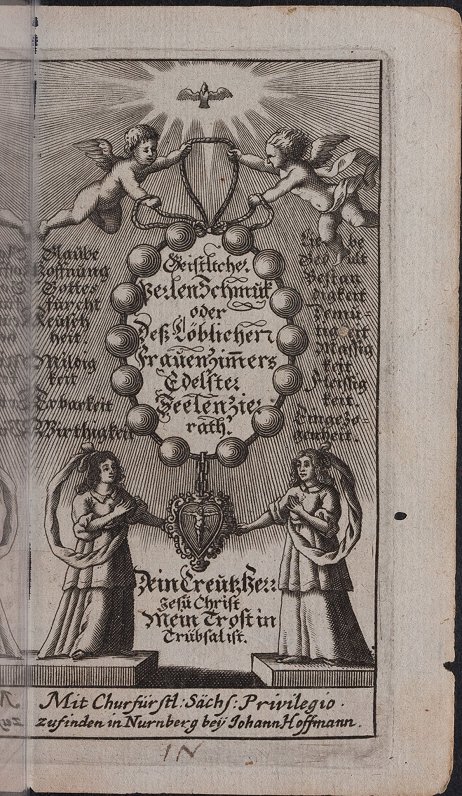
Title page of the 3rd German edition of Strings of Spiritual Pearls (1673) by J. Cundisius
Photo: From the Duke Augustus Library collection in Wolfenbüttel
Strings of Spiritual Pearls by Cundisius consists of eight chapters or strings of pearls – seven of which trace different stages of life and contain spiritual texts for almost every occasion. The Latvian cultural historian Jānis Krēsliņš, Jr. has aptly called this book a kind of 17th-century women's laptop. In the original German edition, each of the eight chapters is introduced by a separate illustration – the characteristic Baroque three-part emblem or symbolic drawing with accompanying text: the top margin contains the chapter title and almost always the keyword of the chapter, the lemma or motto, contained in the pendant of a necklace; below this is the pictura or illustration and the image is concluded by the subscriptio or concise quatrain at the bottom of the page.
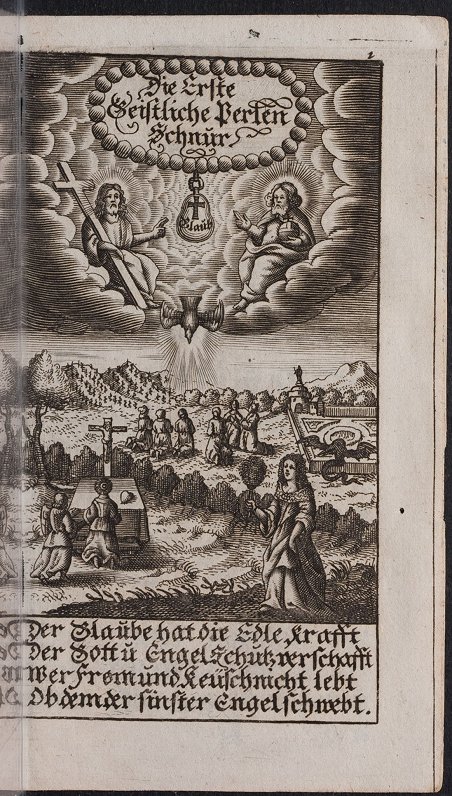
Introduction to Chapter 1 of J. Cundisius’ Strings of Spiritual Pearls (1673).
Photo: From the Duke Augustus Library collection in Wolfenbüttel.
The motto of the first chapter is faith, as shown in the image and the quatrain in the translation: “Faith has a noble strength, / It is provided by God, guarded by angels. / He who does not live piously and purely, / is beset by the angel of darkness". The illustration shows a girl and a hedge, with worldly temptations behind it – a dragon in allegorical form, and the angel of darkness mentioned in the quatrain. The heart on the tombstone is a reminder of the permanence of love, the fan in the girl's hands – of the secret or virginity to be kept until marriage.
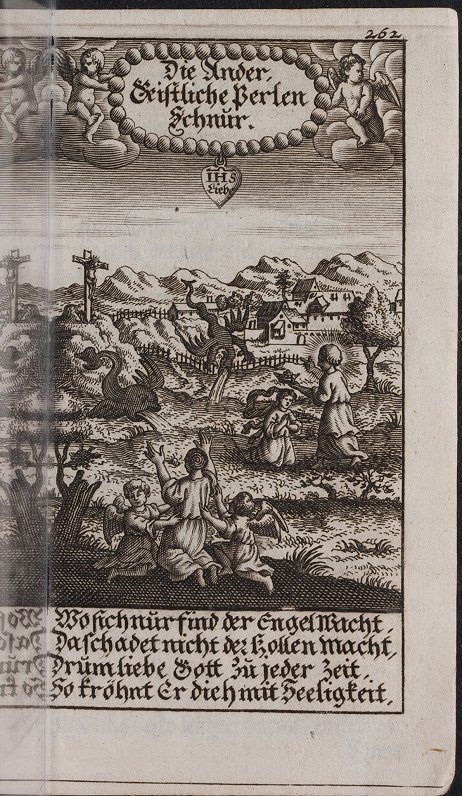
Introduction to Chapter 2 of J. Cundisius’ Strings of Spiritual Pearls (1673).
Photo: From the Duke Augustus Library collection in Wolfenbüttel.
The second chapter contains prayers for daily life – rising in the morning and going to bed at night, starting work, giving thanks for the daily meal, etc. The opening illustration of this chapter also emphasises devotion. The pendant of pearls reminds us of Christ's love and his presence in overcoming temptation. The same is reaffirmed in the quatrain: "Where the power of angels reigns, / the power of hell cannot harm, - / Therefore always love God, / Then he will reward you with blessings."
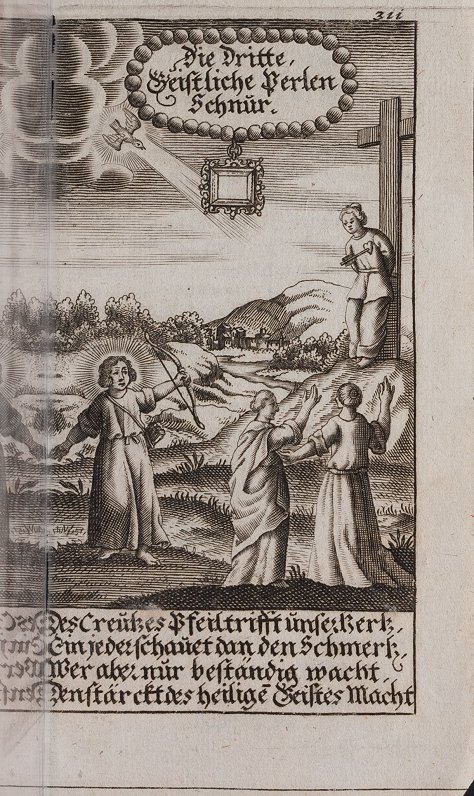
Introduction to Chapter 3 of J. Cundisius’ Strings of Spiritual Pearls (1673).
Photo: From the Duke Augustus Library collection in Wolfenbüttel.
The third string of pearls mainly contains prayers, but relatively few hymns. This section is useful for fulfilling the requirements of various social roles – reflecting on relationships with parents, with neighbours, with the sick, with servants, etc. Faith is also a great support in these situations, as shown in the image and the quatrain: "An arrow sent by the Cross touches our heart/ Everyone feels pain. / He who is always awake / Is strengthened by the power of the Holy Spirit."
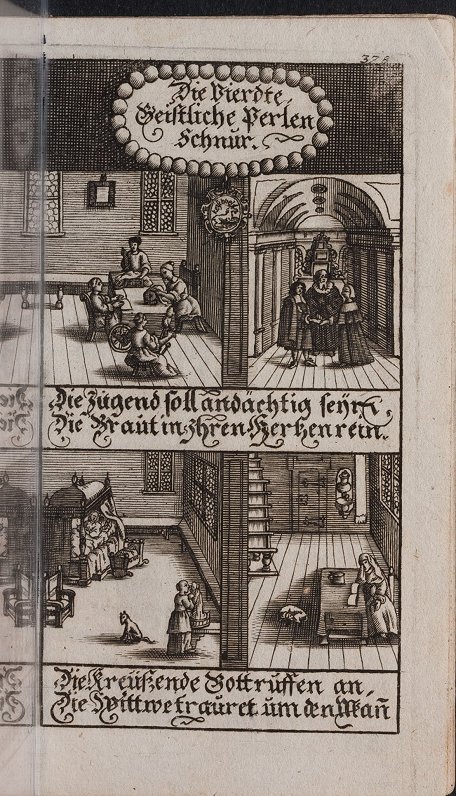
Introduction to Chapter 4 of J. Cundisius’ Strings of Spiritual Pearls (1673).
Photo: From the Duke Augustus Library collection in Wolfenbüttel.
The fourth pearl ornament is meant for brides and newlyweds, as well as women expecting a child and widows. The pendant features a deer, and the motto of the section is ‘Chastity'. The figure of the deer is probably related to Psalm 42: 'As the deer cries out for the rivers of water, so my soul cries out for you, O God'. The quatrain recalls chastity as one of the main virtues of a woman: 'Virtue must be pious, / The bride must be pure in her heart. / The bearer of the cross is called God, / The widow grieves for her husband.’ The picture is divided into four parts, one of which shows a girl doing housework: the hands of a hard-working girl never stand still, work develops diligence and strengthens patience and gentleness.
The second picture shows a marriage, the third a maternity bed, the fourth the grief of a widow. The texts in this chapter – most of them prayers, hymns and practical advice – are related to the family and to expecting a child, without omitting the harsh reality of pain and suffering, as well as words of consolation in the event of the death of the child, the new mother and the husband. As Judith P. Aikin points out, Cundisius’ book is refreshingly different from most other books with similar content. He rarely moralises or reminds us of the sinfulness of women and the suffering of childbirth as a natural punishment but emphasises that the coming of a child into the world is associated with joy.
In Dietz’s translation, Cundisius writes: "To all mothers who struggle within the sorrows of creation / yet after a strange delight it is customary that after the howls, cries and moans / they will again laugh, cheer and shout for joy / and after such long agony / be gladdened by the sight of joy".
His writings are consistent with the Bible and the Gospel of John (16:21): "When a woman gives birth, she is sorrowful, because her hour has come; but when she has given birth to the child, she does not mention her pain, because of her joy that this person has been born into the world". Judith P. Aikin explains the favourable attitude of Cundisius towards women because of his occupation: unlike most other scrivener theologians, Cundisius is a book publisher and poet.
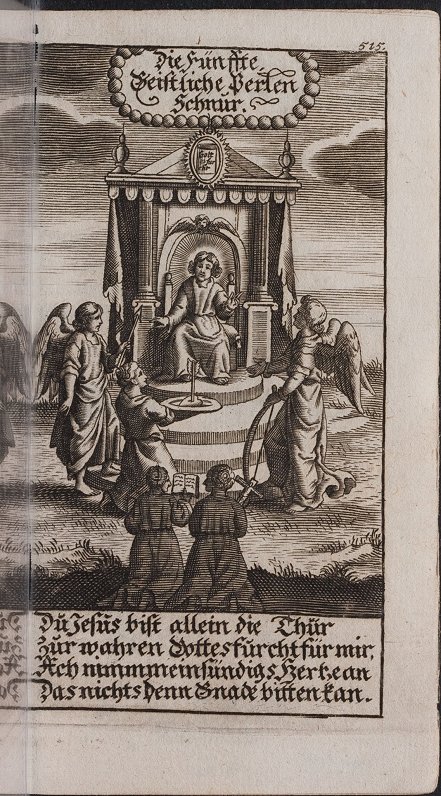
Introduction to Chapter 5 of J. Cundisius’ Strings of Spiritual Pearls (1673).
Photo: From the Duke Augustus Library collection in Wolfenbüttel.
The fifth string of pearls contains texts for confession and communion, its motto is "fear before God", and the same is evidenced by the quatrain: "You, Jesus, are the only door / To my true fear before God, / Oh, accept one sinful heart, / That can ask for nothing but mercy."
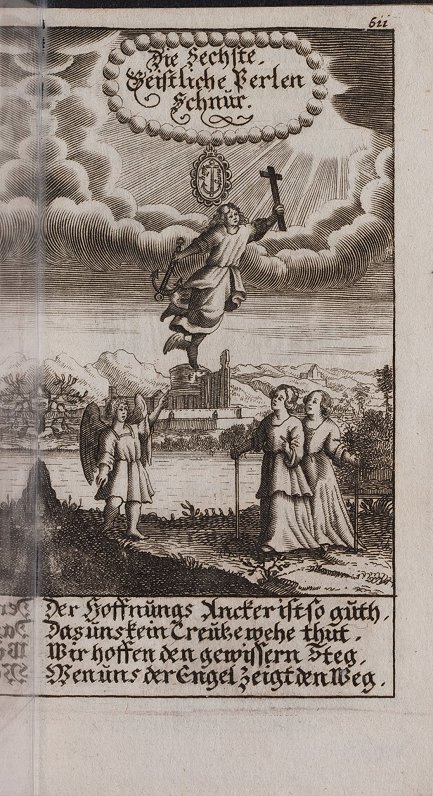
Introduction to Chapter 6 of J. Cundisius’ Strings of Spiritual Pearls (1673).
Photo: From the Duke Augustus Library collection in Wolfenbüttel.
The sixth strand of pearls is for women who are away from home. Its motto includes an anchor or symbol of hope, and the quatrain reminds us of hope: "The anchor of hope is so good, / That no cross gives us pain, / We therefore hope for the path, / Along which the angel will show us the way." I have already mentioned the Baroque notion of the world outside the home as full of hostility, danger and evil temptations. Reading spiritual texts on the road can help to overcome fear and to cope with temptation, fear and panic.
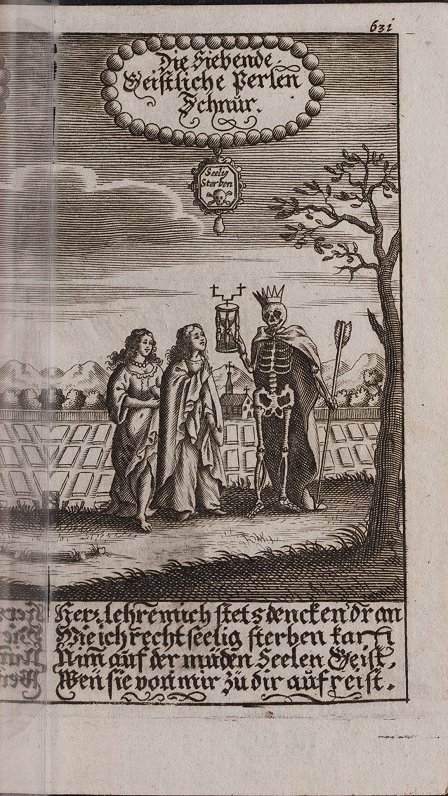
Introduction to Chapter 7 of J. Cundisius’ Strings of Spiritual Pearls (1673).
Photo: From the Duke Augustus Library collection in Wolfenbüttel
The seventh string of pearls contains texts to be read during sickness and on the eve of death, or 'in sickness or when [they] must leave this world'. The motto of the chapter, "to die blessed", is also explained in the quatrain: "Lord, teach me to think continually / How I may truly die blessedly, / Lift up the spirit of the weary soul, / when it rises to you."
The image and the caption suggest learning the art of dying – already thinking about it today. In the image, the skeleton with the hourglass and the cemetery in the background remind us of death, while the small church reminds us of dying with God's blessing. This section contains the most texts for reading when in pain, suffering and when facing death.
As Rudolf Schenda points out, Baroque literature also has a therapeutic function, which involves overcoming pain within an organised social framework. In the 17th century, the room of the ailing woman, just like the room of a woman in labour, is a public space where family members, relatives and neighbours gather, not only to curiously observe the suffering of the sick and perhaps even the deceased, but to console them by singing, reciting prayers and reading to them. Thus, alongside the meagre medical options, it is spiritual support that becomes the key to overcoming pain at a time when there are no other effective remedies.
The book also contains texts especially for the people present – "Sighs of the women standing around", "Touching song of the wives standing around", etc.
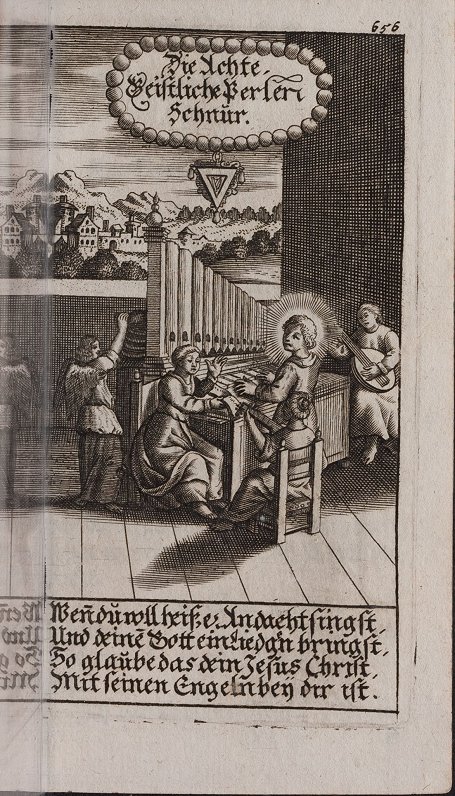
Introduction to Chapter 8 of J. Cundisius’ Strings of Spiritual Pearls (1673).
Photo: From the Duke Augustus Library collection in Wolfenbüttel
The eighth chapter, or string of pearls, is a hymnbook. The motto of the chapter includes the harp, King David's musical instrument, which is also the most frequently used symbol on the title pages of psalms and spiritual hymn books. The picture also shows the portable organ and lute, typical of the Baroque period. The quatrain announces: "If you sing full of fervent devotion, / And bring one song to your God, / Then believe that Jesus Christ / With his angels is with you." This chapter contains 72 hymns, including some composed by Johann Cundisius.
Although it has undergone many reprints over time, the content of the German original of Cundisius' Strings of Spiritual Pearls remains unchanged, but the illustrations change: the women's clothes, hairstyles and, to some extent, accessories change; the periphery of the picture becomes more austere, including the interior of the depicted house. One illustration, that of the seventh string of pearls, experiences a noticeable leap in time.
Whereas previously the image of the two girls meeting death with the hourglass in their hands was static, from the 1713 edition onwards it becomes more expressive. It is no longer a question of mastering the art of dying, but of a person facing death: the skeleton has already drawn his arrow for a fatal strike at the woman's head. The hourglass, shifted into the background, is barely visible. This image, compared with the revelation of the relationship between man and death in the edition from the second half of the 17th century (1667), perhaps best shows the journey of the human spirit from the Baroque era to the Enlightenment.
As Philippe Ariès writes, "Beginning with the eighteenth century, man in western societies tended to give death a new meaning. He exalted, dramatized it, and thought of it as disquieting and greedy. He was less concerned with his own person than with the death of the other, whose loss and memory inspired in the nineteenth and twentieth centuries the new cult of tombs and cemeteries and the romantic, rhetorical treatment of death."
In the 1720 edition of Strings of Spiritual Pearls, several persons are depicted at the beginning of this chapter: one who has already died and is under the tombstone; another, an elderly woman who has come to mourn the deceased and is in tears; and a third, apparently mourning the old woman who is still alive but already touched by death.
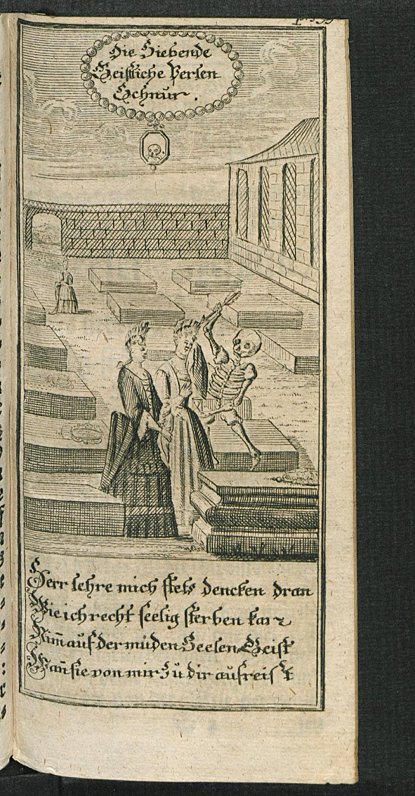
Introduction to Chapter 7 of J. Cundisius’ Strings of Spiritual Pearls (1720).
Photo: from the Berlin State Library collection
Swedish and Latvian translations of Strings of Spiritual Pearls
The first Swedish edition of Strings of Spiritual Pearls was published in Stockholm in 1696 and reprinted in 1709. Neither of these books have illustrations. The title page is also ascetic, without the necklace visible in the German original, but the structure of the collection as a whole and the contents are identical to the German edition by Johann Cundisius.
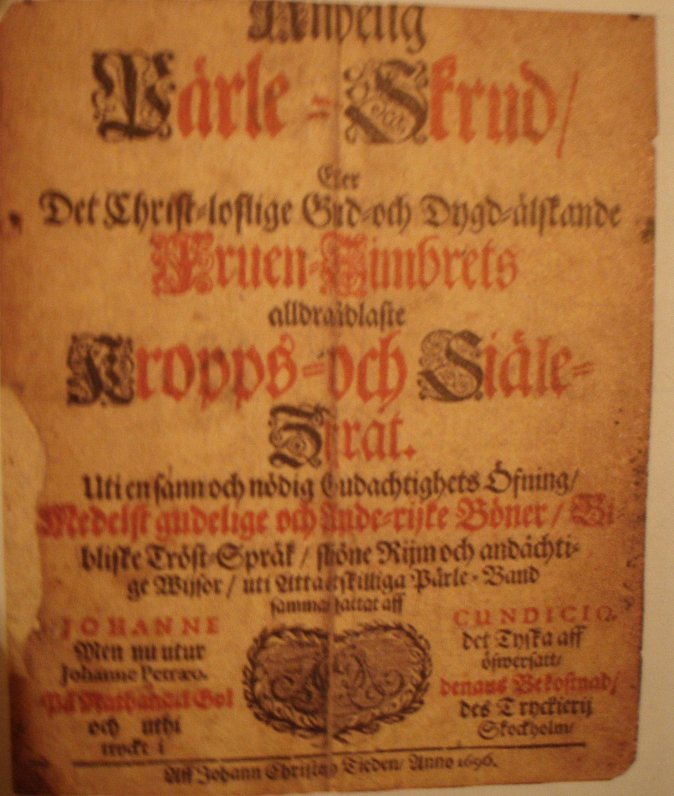
Title page of the Swedish edition (1696) of J. Cundisius' Strings of Spiritual Pearls
Photo: from the Royal Swedish Library collection.
In 1711, Johann Cundisius' Strings of Spiritual Pearls was also published in Latvian. More than 100 years later, in Jelgava, two reprints followed in 1847 and 1867, during the height of Pietism. The first Latvian edition, with the long Baroque-style title "A Spiritual Pearl Adornment, or the precious body and soul of an outstanding Christian female lover of God and good virtues, which lives within the selected prayers of God, pieces of God's writing, rhymes, and many lovely hymns, hitherto unpublished, received in eight different strings or chapters, and written in German for this edition by Johann Cundisius: translated into the language of this land for the glory of God and for the benefit of the Latvian church, and multiple copies made with the necessary prayers" is the first book for Latvian women.
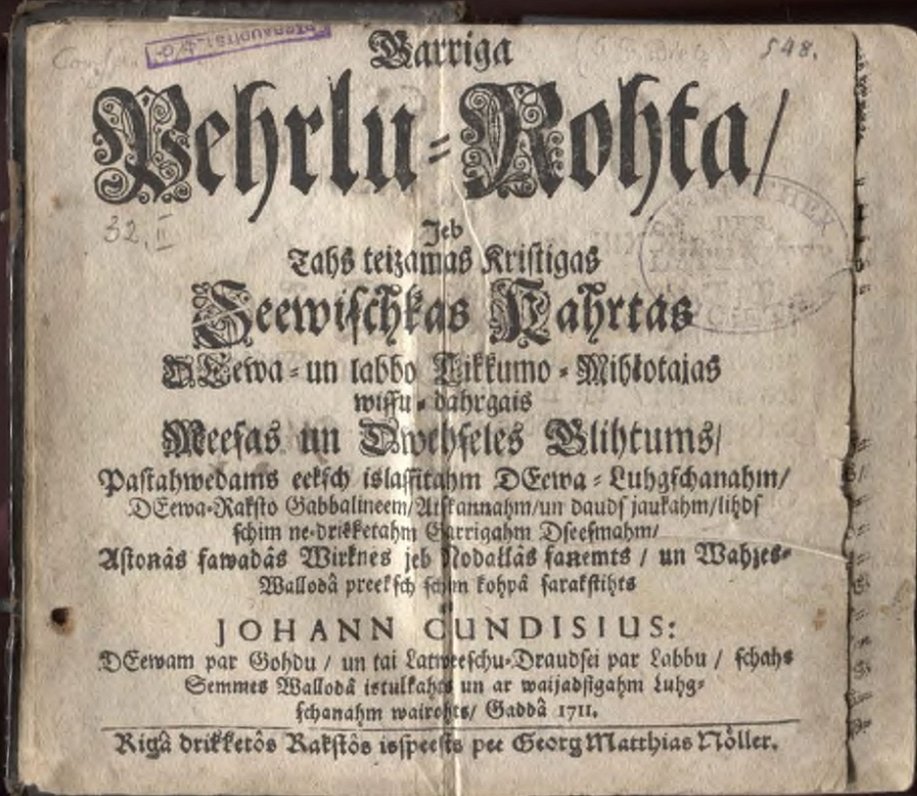
Title page of the first Latvian edition of Strings of Spiritual Pearls, translated by S.G. Dietz (1711).
Photo: from the collection of the Manuscripts and Rare Books Department of the Academic Library of the University of Latvia
At this time, most Latvians were peasants, living in the countryside or working in the cities in low-level jobs, and their level of education was low. Books in Latvian were produced and published by members of the ruling elite – German priests. Strings of Spiritual Pearls was also translated by the pastor Svante Gustav Dietz. Dietz received his initial education at the Riga Lyceum (1681–1687), then studied theology at the Universities of Leipzig and Jena and was awarded a Master’s degree.
Almost all of Dietz's life was spent in the so-called Swedish period, when Livonia was part of the Swedish Empire (1629–1721). Since 1693, Dietz had been serving in the parish of Smiltene, and since 1712 he had also been pastor of the Koknese parish. During the Northern War, at the beginning of the 18th century, Dietz possibly spent several years in Riga. His burial place is unknown, most probably he is buried in the church in Smiltene. Dietz's translation is the first publication of Swedish spiritual literature, and these are then the first Swedish texts in Latvian.
Dietz translated the Swedish Church Handbook (1708), as well as a few dozen Swedish hymns. In total, Dietz translated nearly two hundred hymns mainly from German into Latvian, approaching the level of the great poet from Courland, Christoph Fürecker (1612–1685?) in terms of mastery. Dietz's hymns, just like those of Fürecker, are still included in modern hymnbooks.
Dietz's translation of Strings of Spiritual Pearls is in sound, flamboyant Baroque-style language and close to the German original, except for the eighth chapter, or string of pearls. This is arranged according to different principles. In this chapter Dietz includes 43 hymns not previously translated into Latvian, among them 11 poetic reproductions of texts by Johann Cundisius, as well as 23 translations of hymns from Swedish. In 1711, after almost 100 years of being a part of Sweden, Riga and later the whole Province of Livland became part of the Russian Empire.
The relative similarity of the title pages of the Swedish and Latvian editions of Strings of Spiritual Pearls suggests, at first glance, that Dietz translated the book from Swedish, but the Manuscripts and Rare Books Department of the Academic Library of the University of Latvia in Riga has preserved Dietz's manuscripts, including a hand-drawn draft of the title page of Strings of Spiritual Pearls. This is evidence that the Latvian edition was originally intended as an imitation of the title page of the German edition. Similar to the German string of pearls, Dietz named his virtues for each Latvian pearl: faith, hope, fear of God, chastity, a generous hand, honour, love, patience, perseverance, humility, modesty, virtue, reverence and finally: your cross is my saviour.
The Latvian edition contains no illustrations. The modest setting of the Latvian edition of Cundisius' Strings of Spiritual Pearls, which bears only a passing resemblance to the original in the longitudinal format, is probably due to the poor conditions of the book trade at the beginning of the 18th century, caused by the war and the plague epidemic.
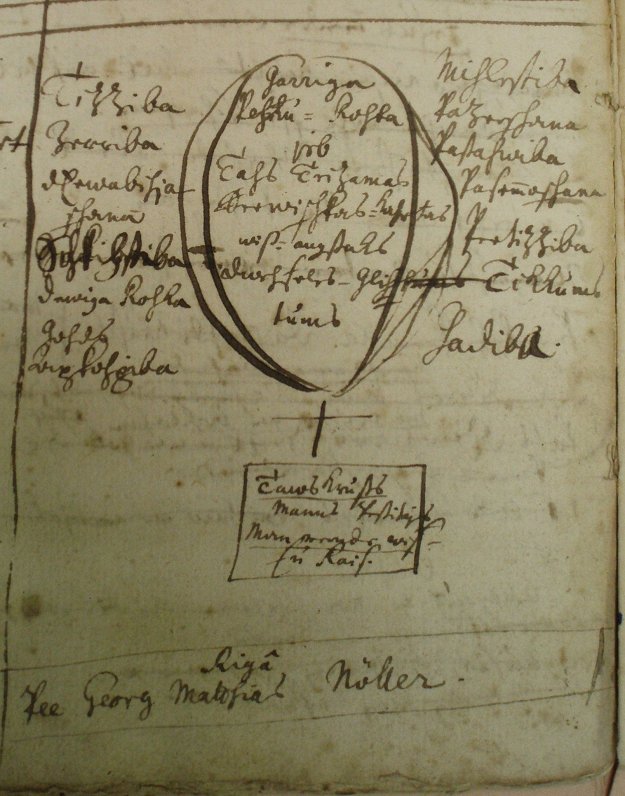
Title page of manuscript of Strings of Spiritual Pearls (before 1711), drawn by S. G. Dietz.
Photo: Rare Books and Manuscripts Department of the Academic Library of the University of Latvia LDB collection, No. 5337
One can only guess what motivated Dietz to print Cundisius' book in Latvian – perhaps the popularity of the genre and the book in the German and Swedish cultural spheres, or perhaps compassion and his own experience – Dietz had 13 children. In the manuscript of Strings of Spiritual Pearls, there is a short note next to the group of hymns "From Cross and Sorrow": "Barbara Beate died on 12 March at 7 a.m.". Barbara Beate would have been nine years old at the time, and she was Dietz's daughter. The lyrics of the hymn translated by Dietz read: “Oh God! I'm pressed hard by Sorrow / Moaning is heaped around me; They turn my heart around, They gather around me / I cry out to you, oh, God! Oh, listen to me, I still look to Thee / Even though my heart is weary."
Perhaps another reason can also be found within the context of that era. According to Estonian scholar Merili Metsvahi, as late as the 18th century, Estonian peasants knew no strict sexual restrictions before marriage, especially in summer, when people slept in stables, barns, hay sheds or worked in the open air and rested there. Marriage is most often linked to pregnancy, but this may not be a reason to marry if, for example, the girl's father does not consider a potential son-in-law to be good enough or the girl does not want to start a family with the child's father. A working woman with a child out of wedlock has little difficulty finding a husband.
In the second half of the 17th century, the first laws are translated into Latvian. The content of the laws echoes the same theme: "The King's Law of Punishment against the Murdering [i.e. murdering or killing] of Children" (1684), which specifies the punishment of those who kill a newborn, and the law "Against the Sins of Immorality Among In-Laws" (1699), which provides for the death penalty for these sins. Also, of the 155 pastoral notes on the peasants of Smiltene parish, recorded between 1697 and 1727, 90 (more than half) are related to extramarital affairs. Dietz also recorded details of immoral young women, marriages registered too late, children born out of wedlock and teachers dismissed for immorality.
And finally, the literary scholar Silke Getsch points out: "The church had a great interest in abolishing the older customs and replacing them with church-institutionalised celebrations, engagements and weddings. (…) to achieve its aim in the long term, it was necessary to mark the boundary between legitimate and illegitimate sexuality through rituals and to legally bind the power of the definition to the church. Regarding betrothal and marriage in the church – it had to be made unambiguously clear that marriage vows made in private could not be proven in court in case of any doubt. By imposing the general institution of betrothal and marriage, the process of legitimisation of folk customs was implemented, which was characteristic of the early modern period".
Some quotes from the Latvian translation of the book
From the introduction:
"God (...) in those distressing times of pestilence smote many thousands, among whom the shepherds and their flock suffered grievously by the heavy hand and sharp rod of God (...) some faithful pastors were carried away too through a secular death, and the daughter of Zion is left like a shed in the vineyard, like a night porch in a cucumber garden, like a ruined city (...) But this little book shows to all females, in particular, who love God and Christ, with what adornment they ought to adorn themselves, if they wish to please God and receive blessings from him, that is, not with braided hair, or with gold, or with pearls, or with costly apparel, but in the service of God and through good deeds (I Tim. 2:9), not by plaiting one’s hair, nor by wearing gold, nor by wearing garments, but in the unfading beauty of that gentle and quiet spirit."
From "A strange morning prayer of a daughter who plans to get a husband," i.e., get married:
"Be to me one loving morning dew, that I bloom within all honourable virtues as a lovely rose that I blossom? in care and honour, as a lovely lily, that my roots flourish and my branches spread like a palm tree, that I am as agile as an olive tree and that my fragrance is as good as frankincense. Adorn my head with the crown of honour which should be worn by honourable daughters, adorn it with that shield of baptized virtue, give that within it the lily of fair love is found; the rose of compatible love; the violet of humble love; that purple? is a remembrance of the crimson blood of thy dear son, which he shed for my sins out of love; that golden flower of righteous constant faith; yes, that sunflower of constant trust and surrender of my mind within thy will".
Advice from chapter four:
"...a young man should consider, aside from all he has learnt, that he can support, provide for and be the head of his wife, children and household with righteousness and honour; a young woman should consider whether she has learned enough, [to know] how she will keep her husband, whether she will be submissive and obedient to him, whether she knows how to lead an honourable life, with cooking, washing, baking bread and such daily activities. If one does not know these things, and cannot, or will not do them, let him not deceive the children of upstanding folk."
"As the husband is the father of [their] life, so also [the wife] is the mother and housewife of [their] life; the righteous God hath made the mother, for all to hear, to be equal in honour with the father. May [she] learn to be quiet, not to hear all things, not to see all things, and not to rebel against her husband, not to be permissive? and harsh in her words, not be self-willed, unremorseful?, proud and angry toward her husband, not to jeer at her husband as if she were his lady and commander, desiring to rectify? him [ i.e. to scrutinise him] and to do everything the way she wants. (...) If thy husband is sometimes rough and a miser [i.e. stingy] towards you, then make him soft in mind through humility and affection through your words, habits, and actions, whereby a wise, gentle wife sometimes overcomes her rough husband's heart and him and does so much that he must again treat her as she wills, and that she may have from him whatever she wills. (...) She should be satisfied with a moderate diet, food, clothing, and other necessities of life, neither should she squander her husband’s money? her husband, nor expect from him more than he is able to provide."
